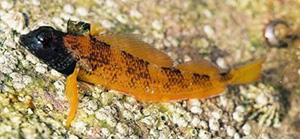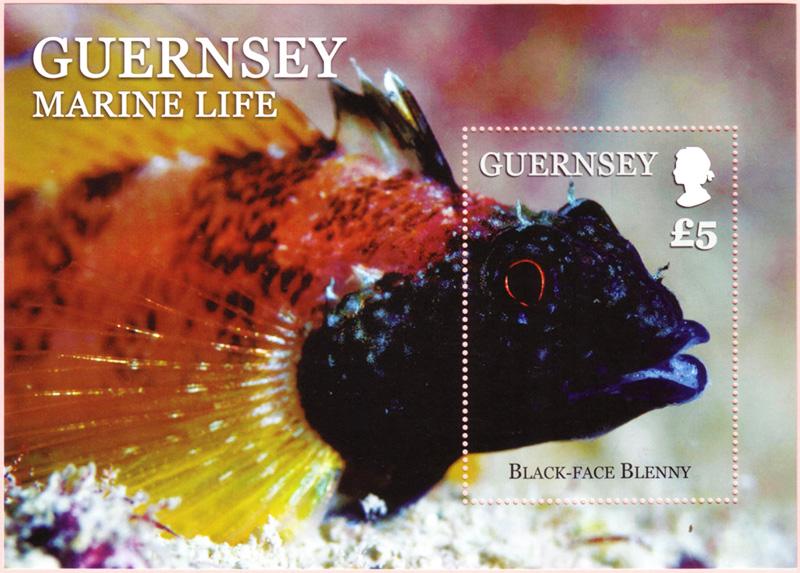Tripterygion delaisi Cadenat and Blache, 1970

(Da: www.glaucus.org.uk)
Phylum: Chordata Haeckel, 1874
Subphylum: Vertebrata Lamarck J-B., 1801
Classe: Actinopterygii Klein, 1885
Ordine: Blenniiformes Rafinesque, 1810
Famiglia: Tripterygiidae Whitley, 1931
Genere: Tripterygion Risso, 1827
Specie e sottospecie
Il genere attualmente annovera le seguenti specie: Notoclinops caerulepunctus Hardy, 1989 - Notoclinops segmentatus McCulloch & Phillipps, 1923 - Notoclinops yaldwyni Hardy, 1987.
Descrizione
Presenta un corpo allungato a sezione arrotondata, tre pinne dorsale e grandi pinne pettorali. La livrea comprende nove bande rosse sul corpo rosa-argenteo, grandi occhi azzurri sulla testa rosa screziata di arancio. Le altre pinne sono trasparenti. Raggiunge una lunghezza massima di 4,4 cm. I maschi presentano un comportamento territoriale durante la stagione riproduttiva. Si nutre di piccoli crostacei (copepodi e anfipodi) e di piccoli parassiti in pesci più grandi.
Diffusione
Questa specie è diffusa in Nuova Zelanda (Isola del Nord) in acque comprese tra circa 1 e 30 m di profondità, dove predilige zone rocciose e ricche di incrostazioni di alghe.
Sinonimi
= Enneapterygius mortenseni Rendahl, 1926 = Notoclinops bucknilli Griffin, 1926 = Tripterygion atlanticus Wheeler & Dunne, 1975 = Tripterygion bucknilli Griffin, 1926 = Tripterygion segmentatum McCulloch & Phillipps, 1923 = Tripterygion xanthosoma Zander & Heymer, 1970.
Bibliografia
–Yokes, B.; Pollard, D.; Kara, M.H.; Francour, P.; Goren, M.; Williams, J.; Craig, M. (2014). "Tripterygion delaisi". IUCN Red List of Threatened Species. 2014.
–Louisy, Patrick (2002). Meeresfische - Westeuropa & Mittelmeer. Stuttgart: Eugen Ulmer Verlag. p. 305.
–Wirtz, Peter (1978). "The behaviour of the mediterranean Tripterygion species (Pisces, Blennioidei)". Zeitschrift für Tierpsychologie. 48 (2): 142-174.
–Bergbauer, Matthias; Bernd, Humberg (1999). Was lebt im Mittelmeer?. Stuttgart: Franckh-Kosmos Verlag. p. 282.
–Neumann, Volker; Paulus, Thomas (2005). Mittelmeeratlas - Fische und ihre Lebensräume. Melle: Mergus-Verlag. p. 1321.
–De Jonge, J.; Videler, J. J. (1989). "Differences between the reproductive biologies of Tripterygion tripteronotus and T. delaisi (Pisces, Perciformes, Tripterygiidae): the adaptive significance of an alternative mating strategy and a red instead of a yellow nuptial colour". Marine Biology. 100 (4): 431-437.
–Meadows, Melissa G.; Anthes, Nils; Dangelmayer, Sandra; Alwany, Magdy A.; Gerlach, Tobias; Schulte, Gregor; Sprenger, Dennis; Theobald, Jennifer; Michiels, Nico K. (2014). "Red fluorescence increases with depth in reef fishes, supporting a visual function, not UV protection". Proceedings of the Royal Society of London B: Biological Sciences. 281 (1790).
–Cadenat, J.; Blache, J. (1970). "Description d'une espèce nouvelle, Tripterygion delaisi sp. nov., provenant de l'île de Gorée (Sénégal) (Pisces, Clinidae)". Bulletin du Muséum National d'Histoire Naturelle. 41: 1097-1105.
–Wucherer, Matthias F.; Michiels, Nico K. (2014). "Regulation of red fluorescent light emission in a cryptic marine fish". Frontiers in Zoology. 11 (1): 1.
–Eastman, Joseph T. (1988). "Ocular morphology in antarctic notothenioid fishes". Journal of Morphology. 196 (3): 283-306.
–Wucherer, Matthias (2013). Perception and modulation of red fluorescence in fishes (PhD Dissertation). University Tübingen.
–Kalb, Nadine; Schneider, Ralf F.; Sprenger, Dennis; Michiels, Nico K. (2015). "The red-fluorescing marine fish Tripterygion delaisi can perceive its own red fluorescent colour". Ethology. 121 (6): 566-576.
–Harant, Ulrike Katharina; Michiels, Nicolaas Karel; Anthes, Nils; Meadows, Melissa Grace (2016). "The consistent difference in red fluorescence in fishes across a 15 m depth gradient is triggered by ambient brightness, not by ambient spectrum". BMC Research Notes. 9: 107.
–Heymer, Armin (1977). "Expériences subaquatiques sur les performances d'orientation et de retour au gite chez Tripterygion tripteronotus et Tripterygion xanthosoma (Blennioidei, Tripterygiidae)". Vie Milieu. 27: 425-435.
–Solomon, Farahnaz Nissa (2015). Connectivity patterns and early life history of the black-faced blenny Tripterygion delaisi (Cadenat and Blache, 1970) (PhD Dissertation). Universidad de Algarve.
–Domingues, Vera S.; Almada, Vitor C.; Santos, Ricardo S.; Brito, Alberto; Bernardi, Giacomo (2006). "Phylogeography and evolution of the triplefin Tripterygion delaisi (Pisces, Blennioidei)". Marine Biology. 150 (3): 509.
–Zander, C. (1972). "Contributions To Ecology and Biology of Blenniidae (Pisces) From Mediterranean Sea". Helgolander Wissenschaftliche Meeresuntersuchungen. 23 (2): 193-231.
–Wirtz, Peter (1980). A revision of the Eastern-Atlantic" Tripterygiidae"(Pisces, Blennioidei) and notes on some Westafrican blennioid fish. Cybium. pp. 83-110.
–Geertjes, Gerard J.; Kamping, Albert; Van Delden, Wilke; Videler, John J. (2001). "Genetic Relationships Among One Non-Endemic and Two Endemic Mediterranean Triplefin Blennies (Pisces, Blennioidei)". Marine Ecology. 22 (3): 255-265.
–Carreras-Carbonell, Josep; Macpherson, Enrique; Pascual, Marta (2005). "Rapid radiation and cryptic speciation in mediterranean triplefin blennies (Pisces: Tripterygiidae) combining multiple genes". Molecular Phylogenetics and Evolution. 37 (3): 751-761.
–Eschmeyer, William N.; Fricke, Ron & van der Laan, Richard (eds.). "Tripterygion delaisi". Catalog of Fishes. California Academy of Sciences. Retrieved 1 June 2019.
–Christopher Scharpf; Kenneth J. Lazara (29 January 2019). "Order BLENNIIFORMES: Families TRIPTERYGIIDAE and DACTYLOSCOPIDAE". The ETYFish Project Fish Name Etymology Database. Christopher Scharpf and Kenneth J. Lazara.

|
Data: 20/02/2013
Emissione: Vita marina Stato: Guernsey |
|---|